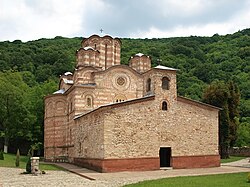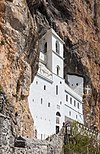Ravanica
 Ravanica church | |
| Monastery information | |
|---|---|
| Full name | Манастир Раваница |
| Order | Serbian Orthodox |
| Established | 1375–1377 |
| Dedicated to | Ascension of Jesus |
| People | |
| Founder(s) | Lazar of Serbia |
| Site | |
| Location | Senje, Ćuprija, Serbia |
| Visible remains | Lazar of Serbia |
| Public access | Yes |
The Ravanica Monastery (Serbian: Манастир Раваница / Manastir Ravanica) is a Serbian Orthodox monastery on Kučaj mountains near Senje, a village in Ćuprija municipality in Central Serbia. It was built in 1375–1377 as an endowment of prince Lazar of Serbia, who is buried there. The Ravanica church is called the birthplace of the new artistic movement "Morava school" because of architectural and artistic features. It is original blend of the Mount Athos and the cross-in-square five-domed model that became standard in the time of King Milutin.[1]
Ravanica was declared Monument of Culture of Exceptional Importance in 1979, and it is protected by Republic of Serbia.
History[]

Built between 1375 and 1377, Ravanica is the famous Prince Lazar's endowment, where he was buried after his death in the Kosovo battle. Since then, Ravanica has been a pilgrim's destination and an important center of cultural activities and the Serbian people's assemblies. The monastery has been assaulted and damaged by the Ottoman Turks several times, in 1386, 1398 and 1436. In the great war after the second siege of Vienna a number of monks were killed. The remaining monks, fleeing the Turkish offensive in 1690, took the relics of the Prince Lazar. a number of monks got killed and the rest of them took the relics of the canonized Prince Lazar and withdrew in face of the Ottoman's offensive in 1690. Only in 1717 was the sole survivor among the monks, teacher Stefan, to come back to Ravanica and find the monastery looted and deserted. With the help of local inhabitants he restored the monastery and built a new narthex. The monastery suffered repeated assaults during the Serbian revolution, at the beginnings of the 19th century. The new restoration took place in the mid-19th century. During the World War II, Germans violated and damaged the monastery once more, and detained, tortured and killed it's archimandrite Makarije on 24 February 1943.
Architecture[]

The monastery church is dedicated to the Ascension of Jesus and was fortified with a strong defensive wall with seven towers, of which only a part is preserved. The Ravanica church is the first monument of the Morava school of the Serbian medieval art. Its ground plan has the form of an enlarged trefoil with a nine-sided dome in the middle and smaller octagonal domes above the corner bays. There are 62 window lights. The church was built in alternate courses of single-line stone and three-line bricks. Valuable ceramic decoration makes use of geometrical patterns, floral motifs, zoomorphic and anthropomorphic shapes.
Art[]

The frescoes were not carried out at the same time and by the same artists. They are dated between 1385 and 1387. The middle-register frescoes, which are of the highest artistic value were painted by two artists, one of them known as Constantine, who left his signature on a fresco of a warrior saint. The noteworthy compositions include the Communion of the Apostles and the Adoration of the Lamb in the altar apse, as well as the festival Cycle in the upper registers of the church. The Ktitor's composition was later repainted, and a fresco of Lazar's death was added. It also depicts Princess Milica and their sons Vuk and Stefan.[2]
See also[]
- Vrdnik-Ravanica Monastery
- Monument of Culture of Exceptional Importance
- Tourism in Serbia
References[]
- ^ "Ravanica". National tourism organization of servia. Archived from the original on 23 October 2014. Retrieved 23 October 2014.
- ^ Jednodnevni Izleti, Resavska Pećina-Ravanica i Manasija Archived 2016-09-04 at the Wayback Machine (in Serbian)
- Starodubcev Tatjana (2012). "On portraits in Ravanica". Zbornik radova Vizantološkog instituta. 49: 333–354.
External links[]
| Wikimedia Commons has media related to Ravanica Monastery. |
- Virtual tour of Ravanica and photo collection of the Blago Fund
- Photos of Ravanica and its frescoes (in Serbian)
- Živorad Janković: Sava, Iguman of Ravanica, "Pravoslavlje", No. 929, 2005. (in Serbian)
Coordinates: 43°57′38″N 21°28′32″E / 43.96056°N 21.47556°E
- Serbian Orthodox monasteries in Serbia
- Cultural Monuments of Exceptional Importance (Serbia)
- Architecture of Serbia
- 1377 establishments in Europe
- 14th-century Serbian Orthodox church buildings
- Burial sites of the Lazarević dynasty




